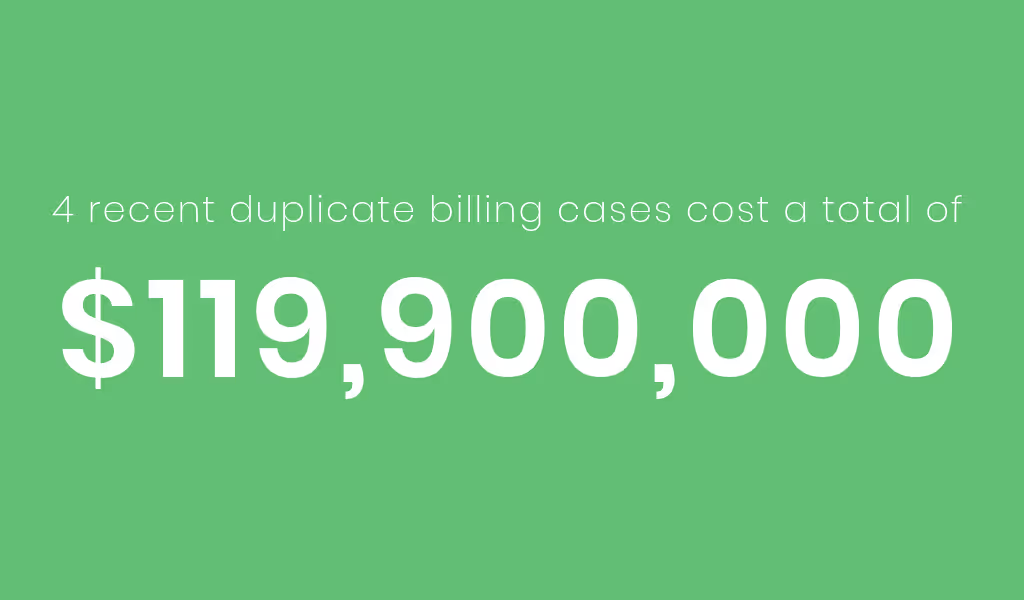Everything You Need to Know About Duplicate Billing
Duplicate billing, also known as double billing, is one of the most common forms of healthcare insurance claim denials but what exactly is it? How does it happen? and how much does it cost?

When working with our healthcare clients, we always ask, “What are some of the most common denials you see?”
If duplicate billing or “double billing” lands within their top five, there is a serious problem. If they continue to ignore that type of denial, government agencies may accuse them of fraud. These fraud cases result in massive fines (more on that later).
Below we’ve listed each topic covered within this blog post for easy navigation.
- How Duplicate Billing Occurs
- Defining an Exact Duplicate Claim
- Defining a Suspect Duplicate Claim
- The True Cost of Duplicate Billing
- 4 Duplicate Billing Fraud Cases
These claim mistakes happen when a healthcare organization...
- Bills for the same patient procedure, treatment, or testing on more than one occasion
- Bills for the wrong patient service
- Bills for patient services that were never performed in the first place
- Attempts to bill Medicare, Medicaid, either another private insurance company or the patient right away
- Charges more than once for the same service
- Doesn't check if they already billed for a procedure
Let's say you’re experiencing migraines that hamper your productivity at work. You have health insurance so you schedule and visit with your physician.
Once you get there, he performs a series of tests. It turns out you're dehydrated. Every test your doctor performed on you has a billing code.
The industry refers to these codes as Current Procedural Terminology (CPT) codes. You can think of these codes as items on a receipt. Each CPT code has its own dollar amount of value based on your health insurance.
Your doctor keeps track of everything performed, finds all their CPT codes and submits the claim.
To further complicate things, your healthcare insurance has a specific process for how they accept claims. To receive payment your doctor must follow that process.
Every insurance company defines how they accept claims within their provider manual. Once your doctor submits the claim, your insurance checks if it meets their criteria.
When your doctor submits the claim, it is their responsibility to record that the submission occurred.
There are thousands of variables these systems use to determine whether to accept or reject a claim. If an insurance company denies a claim, it will go back to your doctor as a Claim Adjustment Reason Codes (CARC) or Remittance Advice Remark Codes (RARC).
If your doctor submits a claim, that will come back as CARC 18, "Exact duplicate claim/service".
There are two main types of duplicate claims; exact and suspect.
The general definition of an exact duplicate claim is pretty straightforward. This type of claim contains the same information as a previously submitted claim. Although that’s the generally accepted definition, it may differ based on the insurance payer.
Anthem BlueCross BlueShield of Texas defines duplicate claims as...
Any claim submitted by a physician or provider for the same service provided to a particular individual on a specified date of service that was included in a previously submitted claim. This does not include corrected claims.
When determining whether or not a claim is a duplicate, Anthem BlueCross BlueShield cross-references the service and dateline to look for matches.
On the other hand, the Centers for Medicare & Medicaid Services (CMS) evaluates the following within claims when determining duplicates...
- Billed amount
- HIC number
- From the date of service
- Place of service
- Procedure code
- Provider number
- Through the date of service
- Type of service
If CMS’ system finds an exact match, the claim will come back to your physician as a denial. Your physician still has a chance to appeal an exact duplicate claim denial and receive payment. But there is a specific appealing process required. Both payer’s we just took a look at caution re-submitting claims until payment’s received without proper evaluation.
If a claim contains similar information to one that was already submitted in the past it will come back labeled as “suspect.”
Suspect duplicate claims will contain the following...
- Matching beneficiary information
- Matching provider identification
- Include the same date of service
Suspected claims are handled similarly to ones marked as exact duplicates, your physician can appeal them.
Below are three immediate costs associated with double billing...
- Delays and/or losses in payment
- Loss in reputation
- Eventual fraud investigation
Receiving a duplicate billing denial has a direct negative impact on your revenue. But the true cost goes far beyond a defined dollar amount.
Negative Patient Word-of-Mouth
Throughout this blog post’s scenario you've been the patient, let's continue.
Imagine your confusion if you receive a medical bill for something you already paid off. You'd likely call your doctor's office, explain that you received a bill for something you already paid, and attempt to remedy the situation. Now imagine this scenario repeating itself every time you visit your physician.
By the third time, you'd want to switch doctors as fast as possible and never recommend that doctor to anyone. That's an entire segment of people that your now-former doctor is losing.
Insurance Company Scrutiny
As the patient, maybe you thought your healthcare insurance company was at fault by the second duplicate bill. Erroring on the side of caution, you give them a call.
After calling, your insurance will begin losing trust in your physician. The more often double billing occurs, the more scrutiny your doctor faces. Your doctor would soon face a series of investigations, audits, and an eventual fraud dispute if he doesn’t change his processes.
But how bad could these fraud cases be?
According to Health Payer Intelligence, 46% of medical fraud cases in 2016 were due to either...
- Fraudulent provider billing
- Double billing
- Billing for services.
These fraudulent cases cost a total of $29 million in fines. But these haven’t stopped since 2016. In fact, the four cases we’ve researched and listed below cost companies more than $119.9 million in total.

Acadia Healthcare
On May 8, 2019, Acadia Healthcare of West Virginia settled to pay the United States a $17 million fraud fine. The accusations were that Acadia and its subsidiary, CRC Health, billed many places for the same treatment. CRC Health was also required to pay $2.2 million to the state of West Virginia.
First, CRC Health collected blood and urine samples from drug testing facilities. Once collected, they then sent the samples to San Diego Reference Laboratory.
The double billing fraud occurred when CRC would bill Acadia. Acadia then paid San Diego Lab while billing West Virginia's Medicaid program. Acadia would then bill Medicaid for all tests performed at San Diego Lab as if they performed them.
Once billed, Medicaid paid the facilities more for the tests than San Diego Lab charged. This complex process went on for six years. From January 2012 to July 2018 Medicaid paid no less than $8.5 million to Acadia's Centers.
Department of Veteran Affairs
From 2016 to 2017, the Department of Veteran Affairs received over 250,000 double-billings. These claims came from medical contractors for private care and cost $66.1 million.
“Because of ineffective controls, OCC failed to identify improper claims.
— VA's Office of Community Case Executive Summary
In one year...
- The VA sent 4,758,759 medical claims
- 253,641 duplicates
- 142,493 of which went to Health Net Federal Services
- 111,148 others went to TriWest Healthcare Alliance Corporation
Three other accounting errors cost the VA another $35.3 million.
Pentec Health Pharmacy
In February 2019 Beckers Hospital Review reported that Pentec Pharmacy agreed to pay $17 million in fraud fines.
The Department of Justice accused Pentec of over-billing Medicaid for wasted amounts of product while compounding its drug, Proplete. The over-billing occurred for 11 years from 2007 - 2018.
The specialty pharmacy also submitted duplicate claims to the Federal Employee Health Benefits Program.
An employee notified the Department of Justice under the False Claims Act as a whistle-blower.
Massachusetts Medicaid Program
In early 2017 Massachusetts discovered $17.6 million in Medicaid spending toward unauthorized, duplicate or potentially fraudulent billings.
From 2016 to 2017, the state's Medicaid program, MassHealth...
- Paid healthcare providers who violated federal laws and regulations
- Made double payments to individuals in adult foster and group adult foster care services
- Made payments to unauthorized dental providers who did not meet MassHealth regulations
The discovery came from more than 13 audits conducted on MassHealth.
Conclusion
Insurance payers are getting better at identifying fraudulent behavior. The Department of Justice continues to establish regional Medicare fraud strike forces. These strike forces’ conduct investigations on fraudulent healthcare providers.
Re-submitting duplicates without proper remediation negatively impacts your revenue and trust. If this form of negligence continues, the healthcare organization will face an investigation and a massive fraud penalty.
What practices do you put in place to avoid duplicate billing?
Additional Readings and Sources
- https://www.aarp.org/health/health-insurance/info-05-2012/health-care-billing-errors-and-fraud.html
- https://www.healthcarefinancenews.com/news/acadia-healthcare-pay-17-million-settlement-medicare-fraud-case
- https://www.azcentral.com/story/news/local/arizona/2018/09/06/audit-va-overpaid-veterans-choice-contractors-101-million/1213250002/
- https://www.military.com/daily-news/2018/09/08/double-billing-private-care-cost-va-101-million-ig-finds.html
- https://www.bcbstx.com/provider/training/duplicate_claim_submissions.html
- https://www.medpmr.com/2016/06/27/medical-billing-and-coding-duplicate-billing-is-a-red-flag/
- http://www.rtacpa.com/blog/tips-on-how-to-avoid-billing-a-duplicate-claim
- https://www.bcbstx.com/provider/training/duplicate_claim_submissions.html
- https://www.beckershospitalreview.com/legal-regulatory-issues/specialty-pharmacy-pays-17m-to-settle-medicare-billing-fraud-lawsuit.html
- https://www.beckershospitalreview.com/finance/audit-finds-massachusetts-medicaid-program-spent-17-6m-on-inappropriate-payments.html
- http://valleypatriot.com/ma-auditor-finds-more-than-17-6m-in-masshealth-fraud/
Emphasize your product's unique features or benefits to differentiate it from competitors
In nec dictum adipiscing pharetra enim etiam scelerisque dolor purus ipsum egestas cursus vulputate arcu egestas ut eu sed mollis consectetur mattis pharetra curabitur et maecenas in mattis fames consectetur ipsum quis risus mauris aliquam ornare nisl purus at ipsum nulla accumsan consectetur vestibulum suspendisse aliquam condimentum scelerisque lacinia pellentesque vestibulum condimentum turpis ligula pharetra dictum sapien facilisis sapien at sagittis et cursus congue.
- Pharetra curabitur et maecenas in mattis fames consectetur ipsum quis risus.
- Justo urna nisi auctor consequat consectetur dolor lectus blandit.
- Eget egestas volutpat lacinia vestibulum vitae mattis hendrerit.
- Ornare elit odio tellus orci bibendum dictum id sem congue enim amet diam.
Incorporate statistics or specific numbers to highlight the effectiveness or popularity of your offering
Convallis pellentesque ullamcorper sapien sed tristique fermentum proin amet quam tincidunt feugiat vitae neque quisque odio ut pellentesque ac mauris eget lectus. Pretium arcu turpis lacus sapien sit at eu sapien duis magna nunc nibh nam non ut nibh ultrices ultrices elementum egestas enim nisl sed cursus pellentesque sit dignissim enim euismod sit et convallis sed pelis viverra quam at nisl sit pharetra enim nisl nec vestibulum posuere in volutpat sed blandit neque risus.

Use time-sensitive language to encourage immediate action, such as "Limited Time Offer
Feugiat vitae neque quisque odio ut pellentesque ac mauris eget lectus. Pretium arcu turpis lacus sapien sit at eu sapien duis magna nunc nibh nam non ut nibh ultrices ultrices elementum egestas enim nisl sed cursus pellentesque sit dignissim enim euismod sit et convallis sed pelis viverra quam at nisl sit pharetra enim nisl nec vestibulum posuere in volutpat sed blandit neque risus.
- Pharetra curabitur et maecenas in mattis fames consectetur ipsum quis risus.
- Justo urna nisi auctor consequat consectetur dolor lectus blandit.
- Eget egestas volutpat lacinia vestibulum vitae mattis hendrerit.
- Ornare elit odio tellus orci bibendum dictum id sem congue enim amet diam.
Address customer pain points directly by showing how your product solves their problems
Feugiat vitae neque quisque odio ut pellentesque ac mauris eget lectus. Pretium arcu turpis lacus sapien sit at eu sapien duis magna nunc nibh nam non ut nibh ultrices ultrices elementum egestas enim nisl sed cursus pellentesque sit dignissim enim euismod sit et convallis sed pelis viverra quam at nisl sit pharetra enim nisl nec vestibulum posuere in volutpat sed blandit neque risus.
Vel etiam vel amet aenean eget in habitasse nunc duis tellus sem turpis risus aliquam ac volutpat tellus eu faucibus ullamcorper.
Tailor titles to your ideal customer segment using phrases like "Designed for Busy Professionals
Sed pretium id nibh id sit felis vitae volutpat volutpat adipiscing at sodales neque lectus mi phasellus commodo at elit suspendisse ornare faucibus lectus purus viverra in nec aliquet commodo et sed sed nisi tempor mi pellentesque arcu viverra pretium duis enim vulputate dignissim etiam ultrices vitae neque urna proin nibh diam turpis augue lacus.




